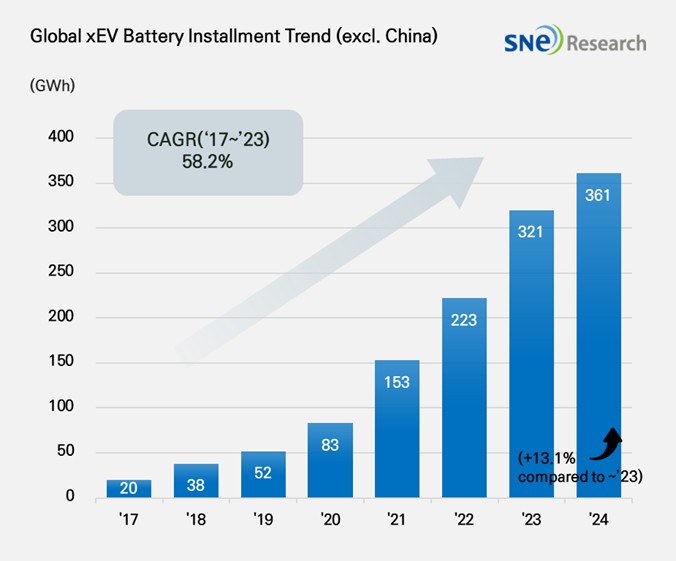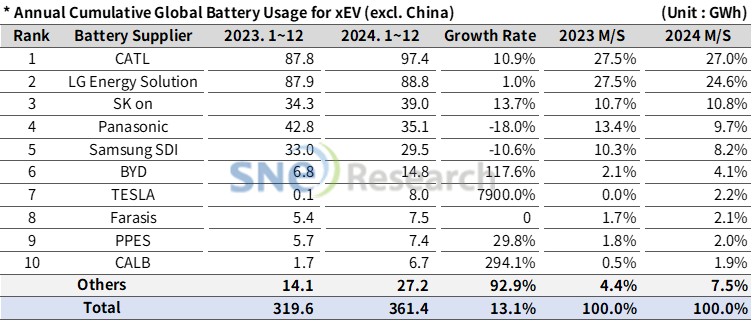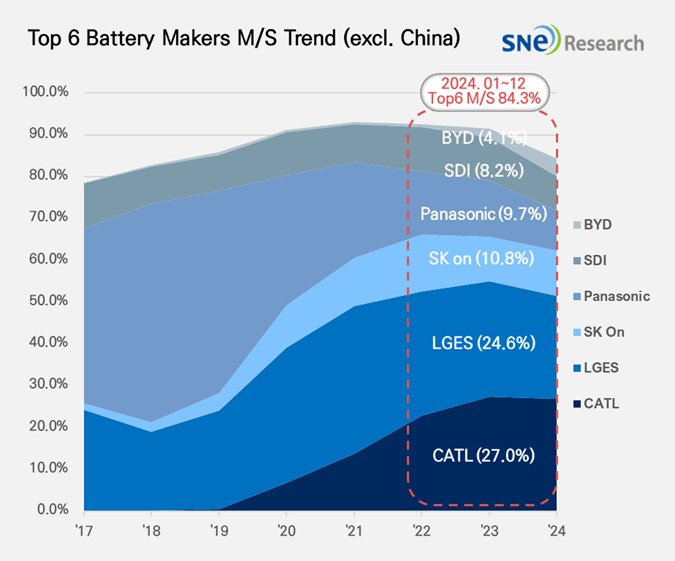From Jan to Dec 2024, Non-Chinese Global[1] EV Battery Usage[2] Posted 361.4GWh, a 13.1% YoY Growth
- K-trio’s combined M/S recorded 43.5% from Jan to Dec 2024
Battery installation for
global electric vehicles (EV, PHEV, HEV) excluding the Chinese market sold from
January to December in 2024 was approximately 361.4GWh, a 13.1% YoY
growth.

(Source: Global EV and Battery Monthly Tracker – Jan 2025, SNE Research)
The combined market shares of LG Energy Solution, SK On, and Samsung SDI in global electric vehicle battery usage from Jan to Dec 2024 posted 43.5%, a 5.0% decline from the same period of last year. LG Energy Solution kept the 2nd position in the ranking with 1.0% (88.8GWh) YoY growth, while SK On ranked 3rd with 13.7% (39.0GWh) YoY growth. On the other hand, Samsung SDI posted a 10.6% (29.5GWh) degrowth. The downward trend in Samsung SDI’s battery usage was mainly caused by a decline in demand for battery from major car OEMSs in Europe and North America.

(Source: Global EV and Battery Monthly Tracker – Jan 2025, SNE Research)
If we look at the usage of battery made by the K-trio in terms of the sales volume of models, Samsung SDI’s battery was mainly used in BMW, followed by Rivian and AUDI. BMW has Samsung SDI’s battery in its models such as i4, i5, i7, and iX, and among these, i5, released at the end of 2023, sold well in the market. On the other hand, even though Rivian posted a steady sale of R1S and R1T in the US, the release of standard-range trim with LFP battery installed had a negative impact on the installment volume of battery made by Samsung SDI. AUDI saw a decrease in sales of Q8 e-Tron, leading to a 30.9% decline in the usage of Samsung SDI’s battery compared to the previous year.
SK On’s battery was mainly installed in EV models made by Hyundai Motor Group, followed by Mercedes-Benz, Ford, and Volkswagen. Hyundai Motor Group saw 60.3% and 59.2% declines in sales of Bongo 3 EV and Porter 2 EV respectively compared to last year. On the other hand, its electric passenger car models – IONIQ 5 and EV6 – experienced a slowdown in sales at the beginning of 2024, but they saw a gradual recovery in sales after the facelifted versions were released. In addition, Kia’s EV9 saw a 235.9% increase in battery usage thanks to an expansion in overseas sales. Mercedes-Benz’s compact SUV EQA and EQB, to which SK On’s battery was installed, posted steady sales similar to the same period of previous year. Other than these, Ford’s F-150 Lightning and VW’s ID.7 recorded favorable sales, having a positive impact on increases in the usage of battery made by SK On.
LG Energy Solution’s battery was mainly used by Tesla, followed by VW, Chevrolet, and Ford. Due to the increase in sales of models equipped with LG Energy Solution batteries, Tesla's usage of LG Energy Solution batteries increased by 10.4%. In particular, the battery usage by facelifted Model 3 increased by 57.2% from last year, which was quite noteworthy. Other than these, Chevrolet’s usage of LG Energy Solution batteries increased by 24.0% thanks to an expansion in the sales of Chevrolet Equinox, Blazer, and Silverado EV to which the Ultium platform was applied.
Panasonic, who supplies its battery mainly to Tesla, ranked 4th in the list with 35.1GWh of its battery used in 2024, but posting an 18.0% YoY degrowth. The major reason for Panasonic’s degrowth were a decline in sales of Tesla Model 3 due to facelift transformation early 2024 and Tesla’s degrowth in sales in 2024. Panasonic, though, is expected to rapidly regain its market share mainly focusing on Tesla in the North American market by launching its advanced 2170 and 4680 cells supplied to Tesla.
CATL remained No. 1 in the global ranking with a 10.9%(97.4GWh) YoY growth, taking up the biggest market share not only in China but also in the global market. Currently, major global OEMs such as Tesla, BMW, Mercedes, Volkswagen, and Hyundai Motor Group adopt CATL’s battery for their electric vehicles. In order to address the oversupply issue in the Chinese domestic market, CATL turned their eyes to overseas markets such as Brazil, Thailand, Israel, and Australia, leading to an expectation that it would rapidly expand its market share around the globe.

(Source: Global EV and Battery Monthly Tracker – Jan 2025, SNE Research)
In 2024, it was noticeable that the Chinese battery makers expanded their market shares in Asia (excl. China) and emerging markets. BYD aggressively made inroads into Korea, Japan, Southeast Asia, and even Europe, increasing its market share. To respond, the K-battery makers are advised to establish different local strategies for regions. In particular, the Indian and Southeastern markets are regarded as key regions where distribution of electric vehicles is to be expanded in future. In order to secure their competitive edge in the market, the Korean battery makers are necessary to come up with a solid product portfolio including LFP battery with cost competitiveness. In addition, it seems crucial for them to optimize battery supply chain through collaboration with local OEMs and actively work on finding new opportunities in emerging markets.
[2] Based on battery installation for xEV registered during the relevant period

